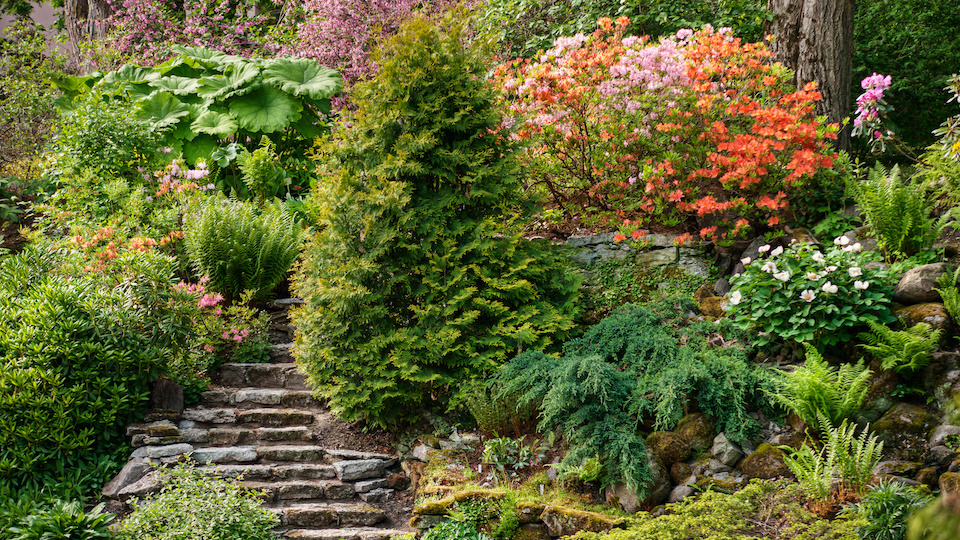Planting a flower bed in a flat area is simple. Choose plants that complement each other, stick them in a pleasing arrangement, dig a hole, give them some water, and you’re good to go. You don’t have to worry about things like erosion control, root hold, and trailing tendencies. Slopes, on the other hand, can be the gardener’s worst nightmare, since you have to take all of these concerns into account and more. If you’re at a loss on how to deal with a slope in your yard, these plants and helpful ideas could be useful.
Before you begin, be sure to remind yourself that gardening on a slope is challenging. It’s physically demanding to plant (depending on the incline of your hill), can be difficult to weed, and finding plants that work can take a lot of trial and error. Stay patient and remember what it was like to try to mow this hill before you turned it into a flower bed. Unless you want to return to the days of your nightmare grass hill, all the effort to plant on your slope will be worth it.
Things to keep in mind when choosing plants
To be honest, any plant can be planted on a hill. But that doesn’t necessarily mean that it will thrive or provide any benefit to your landscape. When choosing what to plant, keep these simple tips in mind:
Low growing
You don’t want massive sunflowers falling all over the slope in front of your house. They will block the view and do nothing to help with erosion control. Stick to low-growing plants that hug the ground and spread out, not up. Groundcovers or any other plants that have sprawling roots are great for holding in soil. You can choose some taller plants to add variety and interest, but plant them with care and be sure to plan carefully to ensure that other plants aren’t covered up.
Evergreen
While some flowers will be a nice addition, you don’t want your prominent hill looking dead and barren throughout the winter. Choose things like flowering, evergreen shrubs, and groundcover. That way, you’ll be able to enjoy the burst of color in the spring and still have good coverage for the rest of the year.
Vines
Any plants with vining tendencies will flourish on a slope. They will trail all over the area quickly and can be trained to fill in bare spots where needed.
Fast-growing
Don’t choose plants that take years to reach maturity and only grow a few inches each season. Not only will this leave your hill looking ugly and unkempt, but it will also leave the soil open to erosion issues and allow the land to wash away in the rain. Instead, pick plants that are hearty, voracious growers. Many types of ground, cover, however, may become invasive, so take care when choosing aggressive plants if you want to have a more varied landscape.
Low maintenance
Plants that require deadheading, frequent trimming, or any other kind of dedicated care should not be considered for slope gardening. Once you have spent time gardening on an incline, you’ll understand why I give this warning. Climbing up and down a hill and bending down to tend to finicky plants is physically demanding and will leave you worn out on garden day before you can even consider touching your other beds.
Drought tolerant
Water-heavy plants will not do well on a slope. Not only does water run off quickly, which means that not as much absorbs into the soil, but to water these plants enough, you may risk causing soil shifting, which can lead to roots getting dislodged and plants washing away. Plus, in areas with water restrictions, you may not have enough water to give them the moisture they need.
For Sun
- California Lilac
- Catmint
- Creeping Juniper
- Forsythia
- Little Bluestem Grass
- Prairie Dropseed
- Rattlesnake Master
- Rockrose
- Rockspray cotoneaster
- Rosemary
- Black Mondo Grass
- Russian Sage
- Shrubby Cinquefoil
- Snowberry
- Star Jasmine
For Shade
- Astilbe
- Common Periwinkle
- Spotted Dead Nettle
- Interrupted fern
- Border grass
- Lily-Of-The-Valley
- Siberian Carpet Cypress
- Creeping myrtle
- Japanese Spurge
Have you ever planted a hillside garden? How did it go? Let us know in the comments below!
-Susan Patterson




